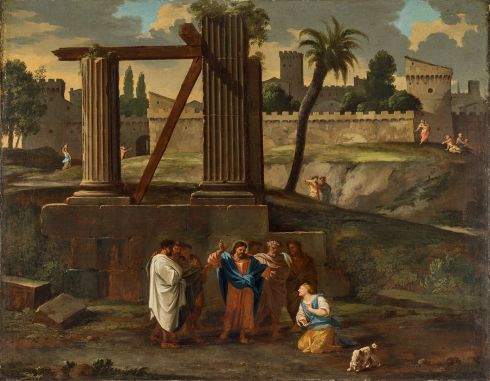Read more
(Paris, 1614 - Lyon, 1689)
Christ and the Woman of Canaan
Provenance :
Osterley Park, inventory of the house taken in August 1782, in the “Breakfast Room”, as by Nicolas Poussin (Tomlin, 1986, p. 122).
New York Julius H. Weitzer (as by Sébastien Bourdon).
Acquired in 1953 by the Chrysler Museum, Norfolk (Virginia).
Sotheby’s, New York, 1 June 1989.
Literature :
Pierre Rosenberg, “France in the Golden Age: A Postscript”, Metropolitan Museum of Art Journal, XVII, 1982, p. 46. Jennifer Montagu, “‘Le Maître de Cléobis et Biton’, de la collection Corsini, le jeune Thomas Blanchet?”, Bulletin de la Société de l’Histoire de l’Art français, 1985, pp. 92, 93, fig. 11, and note 21 (Thomas Blanchet). Lucie Galactéros-de Boissier, Thomas Blanchet. 1614-1689 (Paris: Arthena, 1991), fig. 29, pp. 56 and 62, 348-349, no. P73. Karen Chastagnol, “Un dessin préparatoire pour le Christ et la Cananéenne de Thomas Blanchet”, in Album amicorum. Œuvres choisies pour Arnauld Brejon de Lavergnée (Paris: Librairie des Musées, 2012), pp. 98–99, repr.
Exhibited :
Paris, New York, Chicago, 1982, France in the Golden Age. Paris, Grand Palais; New York, The Metropolitan Museum of Art; Chicago, Art Institute, no. 8, p. 377, repr. (as by an anonymous 17th-century French artist).

Born in Paris, Thomas Blanchet was a key figure on the Lyon art scene in the seventeenth century. After training in the Paris atelier of the sculptor Jacques Sarrazin, he probably soon transferred to that of Simon Vouet when he decided to devote himself to painting. At an unknown date he went to Italy; there is documentary evidence of his presence in Rome from 1647 to 1653 in the stati delle anime, the parish censuses of “souls”, under such exotic appellations as Tomaso Blance, Monsù Blancis and Thomaso Blangett.1 During his stay he was influenced by the seemingly contradictory trends coexisting in Rome at the time: the Classicism of Poussin and the Baroque of Algarde and Andrea Sacchi – both of the latter apparently held him in high regard. His capriccios, stylistically reminiscent of Poussin but compositionally close to Jean Lemaire in their architectural emphasis, quickly became sought after by collectors. In 1652–1653 Blanchet was commissioned to design the mausoleum of René de Voyer d’Argenson in Venice, whose execution was entrusted to Charles-Alphonse Dufresnoy and the sculptor Claude Perreau. In 1655 he moved to Lyon, where he found official status: he decorated the Hôtel de Ville (1655–1672) and the Abbaye des Dames-de-Saint-Pierre (1674–1684, now the Museum of Fine Arts), as well as providing ephemeral decors for celebrations, ceremonies and funerals, often hand in hand with the Jesuit priest Ménestrier. In 1675 he was appointed First Painter of the City and around 1681 he took Cretey, just back from Rome, as one of his collaborators, thus allowing the younger man to make his brilliance known.
Ascribed to Poussin in the eighteenth century, then to Sébastien Bourdon in the twentieth, Christ and the Woman of Canaan belongs to the group of once variously attributed pictures which Jennifer Montagu suggested as being by the “Master of Cleobis and Biton”; her cautious identification of this painter with the young Blanchet played its part in putting together the corpus of his Roman period.2 The stocky figures and the faces with their enormous almondshaped eyes are typical of Blanchet, as is an approach to ruins that contrasts the puissant nobility of antiquity in the foreground with the various buildings and ruins in the background, all painted in shades of creamy brown-beige. At the centre of the lower register is the episode from the Bible: a woman from pagan Canaan has put her faith in the God of Israel and is begging Jesus to save her daughter, possessed by a demon. Jesus is initially silent, then openly disdainful of this member of an idolatrous people; but when she compares herself to a dog eating the crumbs that fall from his master’s table, he recognises the greatness of her faith and cures her daughter.
While the scene gives the picture an evangelical feel, its smallness and the overwhelming presence of the temple betray the artist’s intention to make the landscape his main subject. A preliminary sheet discovered by Karen Chastagnol in the Biblioteca Zelantea in Acireale3 makes it clear that the scene on the recto (ill. 1) was not an integral part of the landscape on the verso (ill. 2), which is bare of all human presence; rather it was an addition of the kind that could have included any other historiated episode. The detail of the little dog that colourfully enlivens the foreground slips in a prosaic element worthy of the bamboccciate of the time.
In this particular instance the shaping of the picture hinges on two factors: on the one hand geometry, which, as is often the case with Blanchet, governs the composition through its stress on right angles; and on the other, a use of the natural world perceptible in the description of this exurban terrain and its anarchic vegetation. The rugged ground markedly inhibits any play on geometrical perspective – only just indicated by the beam leaning against the corner of the fluted pilaster – and any abstract implications it might have. Thus the image is free of the stony aridity to be found in some of Blanchet’s more architectural prospettive. The luscious texture of the paint and the mastery of light eloquently convey an airy freedom and make this one of Blanchet’s most sensitive Roman capriccios.
An old, handwritten label, noted by Jennifer Montagu and Lucie Galactéros-de Boissier but now lost, was marked “Osterley Park Heirloom”. A 1782 inventory4 establishes that in that year the picture was part of the collection in this country house not far from London, where it was hung in the “Breakfast Room” as being by “Nicholas Poussin”.
Mehdi Korchane
1. Galactéros-de Boissier, 1991, p. 51.
2. Montagu, 1985.
3. Chastagnol, 2012.
4. Maurice Tomlin, “The 1782 Inventory of Osterley Park”, Furniture History, 22, 1986, pp. 107-134, quoted p. 122.
Shorten
Read more